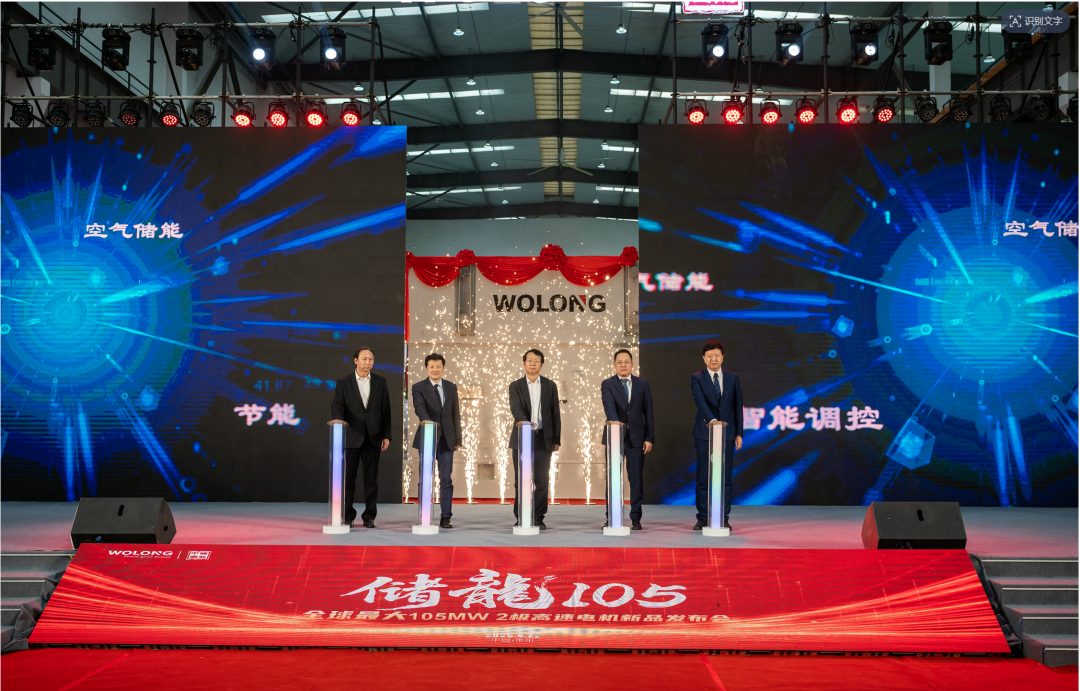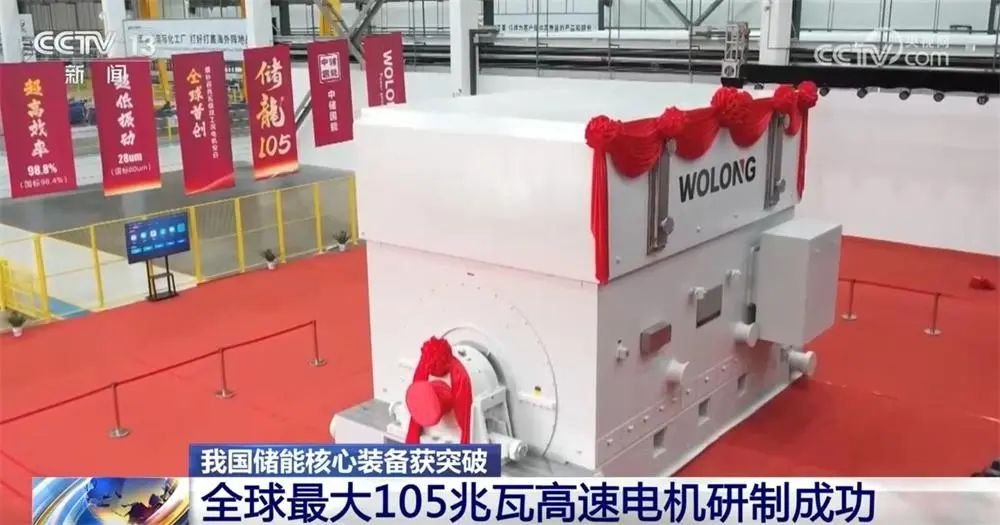April 22, 2025 – The "ChuLong 105," the world's largest 105 MW 2-pole high-speed motor with fully independent intellectual property rights, was officially unveiled in Nanyang, Henan. Jointly developed by Zhongchu Guoneng (Beijing) Technology Co., Ltd. (hereinafter referred to as Zhongchu Guoneng) and Wolong Electric Nanyang Explosion-Proof Group Co., Ltd. (hereinafter referred to as Wolong Electric), this milestone achievement marks a major leap forward in China's energy storage capabilities.
The same day, the "Compressed Air Energy Storage 105 MW 2-Pole High-Speed Motor" successfully passed a product appraisal organized by the China Machinery Industry Federation. The press conference was attended by nearly 200 industry leaders, experts, and media representatives, including:
Wang Zhihui, Secretary of the Nanyang Municipal Party Committee
Chen Haisheng, Director of the Institute of Engineering Thermophysics, Chinese Academy of Sciences, and Chairman of the China Energy Storage Alliance (CNESA)
Song Xiaogang, Secretary-General of the China Machinery Industry Federation
Compressed air energy storage (CAES) is a highly efficient large-scale energy storage technology that stores excess electricity by compressing air during off-peak hours and releases it to generate power during peak demand. The high-speed motor is one of the core components of CAES systems. The newly certified 105 MW 2-pole high-speed motor is China’s first integrated design capable of dual-mode operation (motor/generator), significantly improving equipment utilization across diverse scenarios.
Wan Chuangqi, Executive Director of Wolong Holding Group, stated: "With an efficiency of 98.8% and vibration levels as low as 35 microns (far below the national standard of 80 microns), this motor fills a critical gap in China’s 100 MW-class dual-mode motor technology."
The "Chulong 105" motor achieves over 40% space savings compared to conventional multi-motor configurations of equivalent power output. When integrated into compressed air energy storage systems, it enables a 15-20% increase in regional renewable energy grid integration capacity, with projected annual CO₂ emission reductions reaching 500,000 metric tons.
Overcoming World-Class Challenges
With no mature industry standards or prior technical references, China’s R&D team spent four years tackling unprecedented engineering hurdles. What world-class challenges lie behind this technological breakthrough? Our reporters went behind the scenes at the production facility for an exclusive look.
At Wolong Electric’s production facility, the 3-meter-diameter, 200-ton motor prototype takes shape. According to the project lead, the core challenge of the two-pole high-speed motor lies in its "highly integrated system design" - essentially achieving perfect synergy between a "power engine" and "generation heart" within a single unit.
Precision Manufacturing: Robotic arms apply insulation with 0.01 mm accuracy, ensuring coil consistency within 0.03% tolerance.
Unmatched Durability: Designed for 20,000 start-stop cycles (daily operation), far exceeding conventional motor lifespans.
Aerospace-Grade Stability: Vibration levels are 3 times stricter than national standards, validated on the world’s largest high-speed dynamic balancing platform.
Zhang Xuehui, Deputy General Manager of Zhongchu Guoneng, emphasized: " During the final testing and assembly phase, we further enhanced precision through high-speed dynamic balancing, achieving exceptional vibration performance metrics."
China’s CAES Industry Accelerates Toward Global Leadership
As the second-most mature large-scale physical storage technology after pumped hydro, CAES is entering a phase of rapid industrialization. China now leads globally with over 10 projects under construction, and planned capacity exceeding 10 GW.
In Xinyang, Henan Province, breakthrough progress has been achieved on China's pioneering 300 MW compressed air energy storage (CAES) facility - the world's first to utilize horizontal mountain tunnels as artificial air reservoirs. The excavation of artificial caverns has surpassed the 50% completion mark.
Chen Haisheng, Chairman of CNESA, noted: "China’s CAES technology has advanced from 100 MW to 300 MW in a decade, setting a new global benchmark."
The Energy Storage Industry White Paper 2025 reveals that global new energy storage installations reached 165.4 GW in 2024, with China contributing 43.7 GW of new capacity. Notably, compressed air energy storage (CAES) has emerged as the preferred grid-scale solution due to its long service life and superior safety characteristics.
Song Xiaogang, Secretary-General of the China Machinery Industry Federation, stated: "Compressed air energy storage possesses distinctive advantages in both efficiency and cost-effectiveness, representing tremendous market potential for China."
Compressed air energy storage has been included as a key development focus in China's 14th Five-Year Plan for new energy storage technologies, with multiple regions introducing dedicated subsidy policies. Industry projections indicate that China's compressed air energy storage capacity will exceed 50 GW by 2030, enabling annual CO₂ emission reductions of over 200 million tons - equivalent to shutting down 60 one-gigawatt coal-fired power plants - thereby providing robust support for building a new-type power system.




